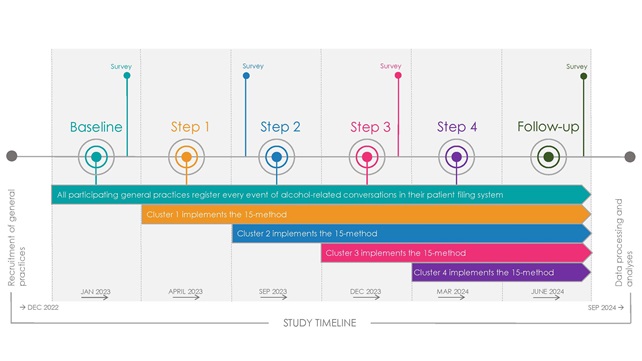Background
Excessive alcohol consumption has a significantly negative impact on public health. Every year, 3,000 deaths are attributed to alcohol-related causes in Denmark. An estimated 15% of Danes engage in harmful alcohol consumption, but only a small group of patients seeks specialized treatment.
Most of the population interacts with general practice, which makes it an ideal setting for identifying issues related to alcohol. However, alcohol problems are often overlooked or perceived to be difficult to manage, and the implementation of effective methods for assisting this group of patients remains a significant challenge.
The iTAPP study aims to test the effectiveness of a new method for identifying and treating alcohol problems among patients in general practice. The method is named ‘the 15-method,’ and it offers an easy way for both patients and practice staff to discuss alcohol problems. The method provides a flexible and patient-centered approach to addressing and treating excessive alcohol consumption.
The 15-method has been developed specifically for general practice. The name refers to the duration of each consultation – 15 minutes – and to the target group for the treatment option included in the method, which is patients who score >15 points using the screening tool AUDIT (Alcohol Use Disorder Identification Test). The method was developed in Sweden and has proven to be as effective in treating mild and moderate alcohol dependence as specialized treatment. The 15-method has been pilot tested in Denmark and adapted to Danish general practice.
Purpose of the study
The iTAPP study seeks to investigate the effectiveness of the 15-method in identifying alcohol problems in general practice, as well as the method’s effectiveness in reducing alcohol consumption among patients who exceed the Danish Health Authority’s recommended weekly alcohol consumption limits. Ultimately, the iTAPP study seeks to evaluate whether the 15-method is recommendable for nationwide implementation.
The 15-method
Visit www.sdu.dk/en/15-metoden to learn more about the 15-method, access practical resources, watch tutorial videos, and more.
Method and design
The 15-method is currently being tested in 18 general practices in the Region of Southern Denmark. The practices are randomly assigned to one of four groups which will implement the method at different times. One group of practices at a time will be trained in the method and will then be ready to use it where relevant. This will be done a total of four times, at three-month intervals, until all 18 practices have received training in the method. Data on the frequency of alcohol-related consultations before and after implementation of the method will be collected via a specific consultation code (ICD-10 research code z006), which is used to register all consultations in which alcohol is discussed. The consultation code is used for research purposes only and does not reflect any alcohol-related topics in the patient’s medical record. Furthermore, data on patient lifestyle, such as alcohol habits, is collected via patient questionnaires four times during the study period.
The figure below depicts the course of the study throughout the intervention period. Each colored line represents a cluster of 4–5 practices. All practices are randomized into groups, each with a different starting point. The intervention period starts with all practices in the control group. The intervention period is set to last 19 months in total. The entire iTAPP study spans four years in the period 2022 to 2025.
Study status
All practices have had the opportunity to try the 15-method for a shorter or longer period. Officially, the intervention period is over, and patients in the participating practices have received the last of four questionnaires. Now follows data processing and analysis, which will culminate in the publication of the study results.

Click on this link to view the image in a larger format (opens as PDF).
References
Schøler, P. N., Søndergaard, J., Barfod, S. & Nielsen, A. S. (2022). Danish feasibility study of a new innovation for treating alcohol disorders in primary care: the 15-method. BMC Prim Care, 23(1), 1-14.
Sundhedsstyrelsen & Statens Institut for Folkesundhed. (2016). Sygdomsbyrden i Danmark: Risikofaktorer.
Sundhedsstyrelsen & Statens Institut for Folkesundhed. (2022). Danskernes Sundhed: Den Nationale Sundhedsprofil 2021.
Sundhedsstyrelsen & Statens Serum Institut. (2015). Alkoholstatistik 2015: Nationale data.
Wallhed Finn, S., Hammarberg, A. & Andreasson, S. (2018). Treatment for Alcohol Dependence in Primary Care Compared to Outpatient Specialist Treatment-A Randomized Controlled Trial. Alcohol, 53(4), 376-385.